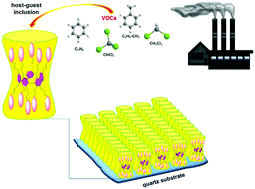Our official English website, www.x-mol.net, welcomes your feedback! (Note: you will need to create a separate account there.)
Preparation of pillar[5]arene-quinoline Langmuir–Blodgett thin films for detection of volatile organic compounds with host–guest principles
Analyst ( IF 4.2 ) Pub Date : 2017-08-14 00:00:00 , DOI: 10.1039/c7an00621g Ahmed Nuri Kursunlu 1, 2, 3, 4, 5 , Yaser Acikbas 5, 6, 7, 8, 9 , Mustafa Ozmen 1, 2, 3, 4, 5 , Matem Erdogan 2, 5, 10, 11, 12 , Rifat Capan 2, 5, 10, 11, 12
Analyst ( IF 4.2 ) Pub Date : 2017-08-14 00:00:00 , DOI: 10.1039/c7an00621g Ahmed Nuri Kursunlu 1, 2, 3, 4, 5 , Yaser Acikbas 5, 6, 7, 8, 9 , Mustafa Ozmen 1, 2, 3, 4, 5 , Matem Erdogan 2, 5, 10, 11, 12 , Rifat Capan 2, 5, 10, 11, 12
Affiliation

|
In this study, a novel pillar[5]arene-quinoline (P5-Q) as an organic material is used to fabricate Langmuir–Blodgett (LB) thin films and its organic vapor sensing properties have been investigated. The LB deposition process is characterized by UV-visible spectroscopy, atomic force microscopy (AFM), scanning electron microscopy (SEM) and quartz crystal microbalance (QCM) techniques. The typical frequency shift per layer is obtained as 31.75 Hz per layer and the deposited mass onto a quartz crystal is calculated to be 539.69 ng per layer (2.03 ng mm−2). The fitted surface plasmon resonance (SPR) data were utilized to calculate the film thickness of this material. The thickness of a single layer is calculated to be 1.26 ± 0.09 nm. QCM and SPR systems are used to investigate gas sensing performance of macrocyclic LB films during exposure to Volatile Organic Compounds (VOCs). The macrocyclic LB thin films are more sensitive to dichloromethane than that of other vapors used in this study. The sensitivity and detection limit performance of the P5-Q QCM sensor to dichloromethane vapor were calculated to be 14.751 Hz ppm−1 and 0.203 ppm, respectively. These results demonstrated that the P5-Q material is promising as an organic vapor sensing device at room temperature. Despite Langmuir–Blodgett being a traditional technique in colloid and interface science, this study presents the first gas sensor application for pillararene LB films. Because of the unique symmetric pillar architecture of P5-Q, self-assembly of pillar[5]arene molecules should afford various characteristic nanometer-scale architectures such as micelles, vesicles, and tubes.
中文翻译:

制备柱状[5]芳烃-喹啉Langmuir-Blodgett薄膜,用于利用主-客体原理检测挥发性有机化合物
在这项研究中,一种新型的支柱[5]芳烃-喹啉(P5-Q)作为有机材料被用于制造Langmuir-Blodgett(LB)薄膜,并对其有机蒸气感测特性进行了研究。LB沉积过程的特征在于紫外可见光谱,原子力显微镜(AFM),扫描电子显微镜(SEM)和石英晶体微量天平(QCM)技术。每层的典型频移为每层31.75 Hz,计算出的在石英晶体上的沉积质量为每层539.69 ng(2.03 ng mm -2)。拟合的表面等离子体共振(SPR)数据用于计算该材料的膜厚度。计算出的单层厚度为1.26±0.09 nm。QCM和SPR系统用于研究挥发性有机化合物(VOC)暴露期间大环LB膜的气敏性能。与本研究中使用的其他蒸气相比,大环LB薄膜对二氯甲烷更敏感。经计算,P5-Q QCM传感器对二氯甲烷蒸气的灵敏度和检测极限性能分别为14.751 Hz ppm -1和0.203 ppm。这些结果表明,P5-Q该材料有望在室温下用作有机蒸气感测设备。尽管Langmuir-Blodgett是胶体和界面科学中的传统技术,但本研究还是提出了第一种用于柱状芳烃LB膜的气体传感器。由于P5-Q具有独特的对称柱结构,因此柱[5]芳烃分子的自组装应提供各种特征性的纳米级结构,例如胶束,囊泡和管。
更新日期:2017-09-25
中文翻译:

制备柱状[5]芳烃-喹啉Langmuir-Blodgett薄膜,用于利用主-客体原理检测挥发性有机化合物
在这项研究中,一种新型的支柱[5]芳烃-喹啉(P5-Q)作为有机材料被用于制造Langmuir-Blodgett(LB)薄膜,并对其有机蒸气感测特性进行了研究。LB沉积过程的特征在于紫外可见光谱,原子力显微镜(AFM),扫描电子显微镜(SEM)和石英晶体微量天平(QCM)技术。每层的典型频移为每层31.75 Hz,计算出的在石英晶体上的沉积质量为每层539.69 ng(2.03 ng mm -2)。拟合的表面等离子体共振(SPR)数据用于计算该材料的膜厚度。计算出的单层厚度为1.26±0.09 nm。QCM和SPR系统用于研究挥发性有机化合物(VOC)暴露期间大环LB膜的气敏性能。与本研究中使用的其他蒸气相比,大环LB薄膜对二氯甲烷更敏感。经计算,P5-Q QCM传感器对二氯甲烷蒸气的灵敏度和检测极限性能分别为14.751 Hz ppm -1和0.203 ppm。这些结果表明,P5-Q该材料有望在室温下用作有机蒸气感测设备。尽管Langmuir-Blodgett是胶体和界面科学中的传统技术,但本研究还是提出了第一种用于柱状芳烃LB膜的气体传感器。由于P5-Q具有独特的对称柱结构,因此柱[5]芳烃分子的自组装应提供各种特征性的纳米级结构,例如胶束,囊泡和管。


























 京公网安备 11010802027423号
京公网安备 11010802027423号